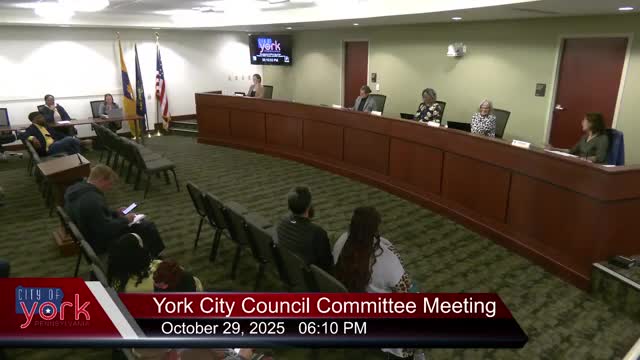Council committee advances York SafeNet camera resolution after hours of public comment
October 30, 2025 | York City, York County, Pennsylvania
This article was created by AI summarizing key points discussed. AI makes mistakes, so for full details and context, please refer to the video of the full meeting. Please report any errors so we can fix them. Report an error »

A resolution authorizing York SafeNet to access city infrastructure for a proposed public–private security camera network was advanced to the Nov. 5 legislative agenda after extended public comment and council discussion.
Otto (Logos Works), representing the York SafeNet initiative, described the project as a nonprofit, membership-funded public safety network that would use city poles and rights-of-way for camera placement. "The York SafeNet initiative is a public private partnership," he said, adding the group had revised its policy to address earlier concerns and posted those revisions at yorksafenet.org.
Council members and residents emphasized accountability, transparency and limits on technology during the committee discussion. The presiding officer summarized earlier public concerns — including civil-rights and privacy risks, the potential for facial recognition or other biometric uses, and the role of private employees operating equipment on public infrastructure — and noted York SafeNet submitted a revised policy forbidding facial-recognition functionality, limiting footage retention to 30 days, requiring law-enforcement requests to show legal rationale, maintaining a public log of police requests and agreeing to independent audits.
Several council members asked for a more concrete timeline and governance steps. One member proposed creating the community oversight/advisory board "sooner rather than later," suggested authorizing a smaller initial deployment (citing 55 cameras as a possible starting point instead of the 140 figure in the original feasibility study) and requested semi-regular updates to council as the project develops. Council also discussed how the system might interoperate with the existing night-watch and private camera registry and whether those registries could be integrated.
Public speakers were split. Some residents emphasized privacy, civil-rights safeguards and the need for enforceable language guaranteeing the right to seek remedies if promises are not kept. Others favored cameras as an investigative tool and offered personal testimony: one speaker said unsolved gun homicides in his family might have been aided by camera footage; York City Police Detective Commander Andy Baez testified that community cameras (doorbell, vehicle and fixed cameras) had aided investigations in recent years and that additional fixed cameras could improve evidence collection and prosecutorial outcomes.
In response to questions about scope and access, York SafeNet representatives said the current request to council is limited: access to city infrastructure so the nonprofit can solicit stakeholders and funding. They characterized the revised policy as an attempt to balance public-safety benefits with constitutional protections.
The committee took a voice vote on placing Resolution 68 on the Nov. 5 legislative agenda; the presiding officer announced the motion carried with 'ayes' and no recorded opposition.
Next steps: the resolution will appear on the November 5 legislative agenda, where council will have the opportunity to consider detailed policy language, membership agreements and any binding contractual terms assigning responsibilities, data access rules and enforcement mechanisms.
Otto (Logos Works), representing the York SafeNet initiative, described the project as a nonprofit, membership-funded public safety network that would use city poles and rights-of-way for camera placement. "The York SafeNet initiative is a public private partnership," he said, adding the group had revised its policy to address earlier concerns and posted those revisions at yorksafenet.org.
Council members and residents emphasized accountability, transparency and limits on technology during the committee discussion. The presiding officer summarized earlier public concerns — including civil-rights and privacy risks, the potential for facial recognition or other biometric uses, and the role of private employees operating equipment on public infrastructure — and noted York SafeNet submitted a revised policy forbidding facial-recognition functionality, limiting footage retention to 30 days, requiring law-enforcement requests to show legal rationale, maintaining a public log of police requests and agreeing to independent audits.
Several council members asked for a more concrete timeline and governance steps. One member proposed creating the community oversight/advisory board "sooner rather than later," suggested authorizing a smaller initial deployment (citing 55 cameras as a possible starting point instead of the 140 figure in the original feasibility study) and requested semi-regular updates to council as the project develops. Council also discussed how the system might interoperate with the existing night-watch and private camera registry and whether those registries could be integrated.
Public speakers were split. Some residents emphasized privacy, civil-rights safeguards and the need for enforceable language guaranteeing the right to seek remedies if promises are not kept. Others favored cameras as an investigative tool and offered personal testimony: one speaker said unsolved gun homicides in his family might have been aided by camera footage; York City Police Detective Commander Andy Baez testified that community cameras (doorbell, vehicle and fixed cameras) had aided investigations in recent years and that additional fixed cameras could improve evidence collection and prosecutorial outcomes.
In response to questions about scope and access, York SafeNet representatives said the current request to council is limited: access to city infrastructure so the nonprofit can solicit stakeholders and funding. They characterized the revised policy as an attempt to balance public-safety benefits with constitutional protections.
The committee took a voice vote on placing Resolution 68 on the Nov. 5 legislative agenda; the presiding officer announced the motion carried with 'ayes' and no recorded opposition.
Next steps: the resolution will appear on the November 5 legislative agenda, where council will have the opportunity to consider detailed policy language, membership agreements and any binding contractual terms assigning responsibilities, data access rules and enforcement mechanisms.
View full meeting
This article is based on a recent meeting—watch the full video and explore the complete transcript for deeper insights into the discussion.
View full meeting